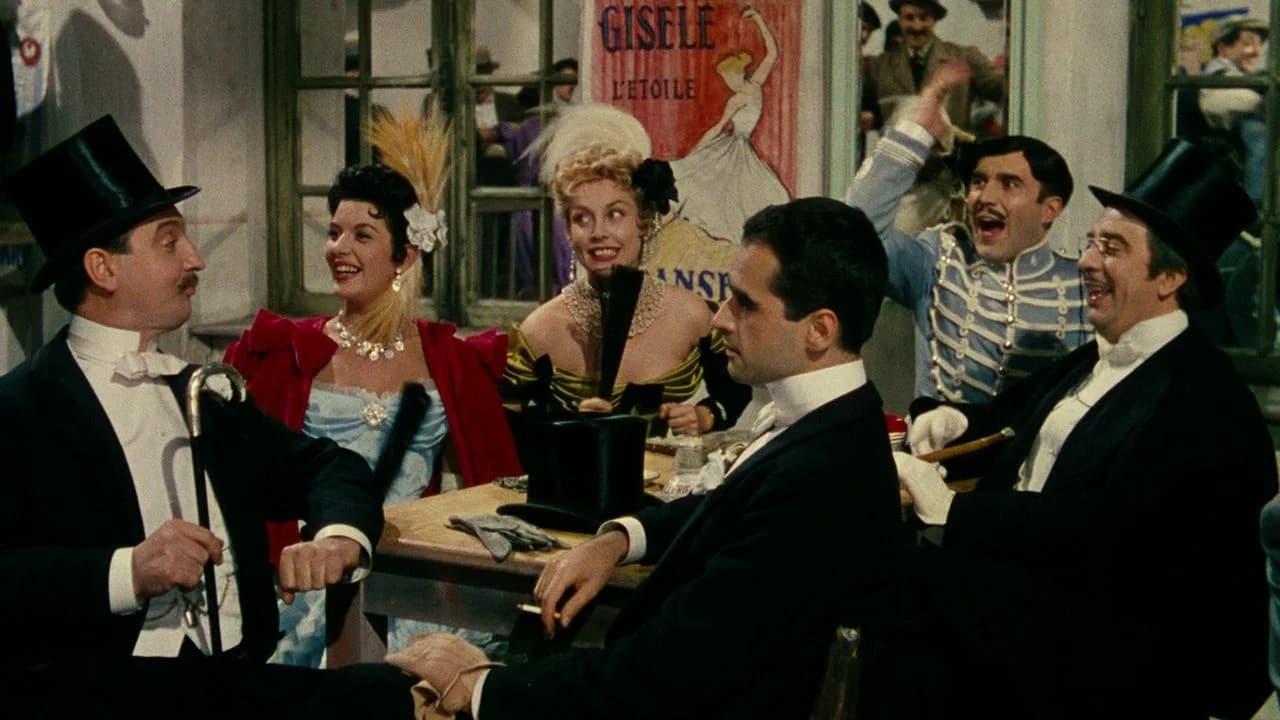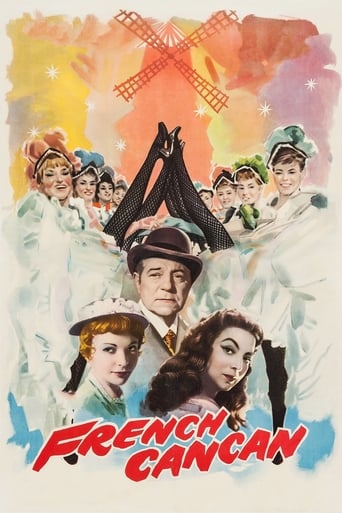

Portrait of a time. portrait of a legend. seductive for the genius of Jean Renoir. and for the inspired performances. and, sure, for the nostalgia of the viewer. an admirable Jean Gabin and a great embroidery of love stories, show world, rivalries and triumph. optimistic, romantic. and refreshing. and that does to it a special status. like refuge, splendid show, fairy tale and confession of a lost age.
... View MoreBrilliantly made, colourful and gay, all the technical full-fledged resources of the vast experience of Jean Renoir is used in flamboyance, but it doesn't help. The story is hopelessly thin and superficial, almost stupid in its simplicity, the characters are all just casual types with very few exceptions, there is no drama at all except in flash moments, and even Jean Gabin falls flat and for once does not die in the end.Nevertheless, the finale is breathtaking with its ten minutes of ballet, and the film is worth watching if only for this, while all the rest is just flippant nonsense. There is not even any real sense of humour. His previous "The Golden Coach" was over-brimming with that, and it's surprising that Jean Renoir left that vital ingredient totally out of this movie more made 'at home'. Even the music is insipid.I saw it in black and white 50 years ago on television and was disappointed by its inanity. I thought it could be worth being given a second chance and in colour. but alas - it was still only a very casual flippant totally superficial entertainment of no real sense and meaning, in spite of all its technical brilliance. Jacques Demy would soon come with the real stuff on stage with much better music.
... View MoreSomeone once described this film as a wonderful soufflé and they were quite right. Light-hearted and full of zest for life, the bold colours reflect the pure joy and optimism bursting from this Renoir vehicle.Unlike a Hollywood musical however, there is a slightly dark undertone that gives this film more depth. The lead character, played by the ever-talented Françoise Arnoul is an anti-heroine and the does little to generate empathy from her audience. Disloyal, selfish and ambitious her love affairs highlight her capricious nature and result in one attempted suicide.Far more likable are the male leads, each of whom is an interesting and, for a musical, well-drawn character, particularly the aristocrat who attempts suicide after he is treated so poorly by the girl. Bravely, Renoir leaves the love affair unresolved at the end, just as it would be in real life. The musical numbers are well-choreographed, the climax being one of the most dazzling scenes ever filmed with dancers bursting forth and flying everywhere. The pace of the film is rapid, reflecting the energy of the dance numbers. The sets are perhaps a little too sanitised for the music halls of the late nineteenth century but they reflect a nostalgia for an idealised past and a hope for the future as Europe left the Second World War behind. The lighting is bright throughout again reflecting the new optimism of the post-war age. Even in the darkest scenes of the clashes between Arnoul and her lovers, there is a brightness that, ironically, works well.Ultimately, this is a film about optimism but it is not a naive optimism that everything will be perfect. Hard choices will need to be made and people will be as selfish and ambitious as ever and the good people who try to care for them will still suffer through their total disregard for the feelings of others. Nevertheless, there is a hope that things are improving and that basic joys like that of the music hall and light entertainment, however banal, can be enjoyed once more with an innocence regained after the darkness of the 1940s and the reign of the Vichy Government.
... View MoreFrench Cancan is the type of film that cannot be made anymore, at least not in America. It is full of joy, joie de vivre, and an overwhelming sense of hope and encouragement. The genius of Jean Renoir lies in his ability to take a simple, rather mundane story and transform it with brilliant color palates, charming actors and gorgeous scenery that recalls earlier Hollywood musicals such as An American in Paris. Jean Gabin, that wonderful actor who also worked with Renoir in films like Grand Illusion and The Lower Depths, lends his easy-going charm and grace to the role of Dugland, a respected but unsuccessful dance club owner who decides to revive the classic French dance of the cancan, which requires finding fresh new faces complete with long, slim, flexible legs. The best dancer he finds is a laundress named Nini, played by Francoise Arnoul with such elegance and beauty it is hard to think of another actress with such charisma. She is truly a work of art herself and gives the film a whole other dimension with her smile and naiveté. Overall, the climatic scene is what truly grabs you. After the somewhat clichéd arguments between lovers and quarrels over rights of sleeping partners, we finally get to see what we want: a group of beautiful French girls dance the cancan. Beyond even that, Renoir films it at a high-pace energy level along with dazzling colors that fill our senses with wonder. Indeed, here we see the genius of Renoir not only in his ability to transform this material but also in showing foreign audiences the essence of French culture. Known to the outside world as impulsive, highly passionate people, Renoir seems to defend their behavior through dance and the reasons for which they celebrate life. Whether you like the French as a people or not, Renoir makes it very difficult to not appreciate their culture and all the richness and joy that comes with it.
... View More